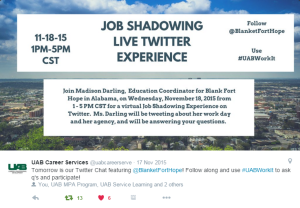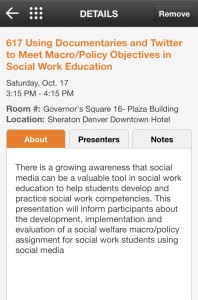Job Shadowing on Twitter
 I’m always looking for a new way to incorporate Twitter into my social work courses. So I was pleased when my colleague Joy Jones with UAB’s Career and Professional Services suggested a new idea to me – a virtual job shadowing experience on Twitter. The event goes like this – a professional agrees to tweet about her job during a set date and time, students can follow along via Twitter, and then tweet back questions or comments to the professional. Similar to a live twitter chat, students can use a computer, tablet or mobile device from anywhere, offering flexibility and the opportunity to engage with others who are also following the job shadowing. Joy had all the details worked out for an event including the job shadowing candidate, logistics, and a hashtag. All I had to do was recruit the students. I offered it as an extra credit opportunity for students in my two classes last semester.
I’m always looking for a new way to incorporate Twitter into my social work courses. So I was pleased when my colleague Joy Jones with UAB’s Career and Professional Services suggested a new idea to me – a virtual job shadowing experience on Twitter. The event goes like this – a professional agrees to tweet about her job during a set date and time, students can follow along via Twitter, and then tweet back questions or comments to the professional. Similar to a live twitter chat, students can use a computer, tablet or mobile device from anywhere, offering flexibility and the opportunity to engage with others who are also following the job shadowing. Joy had all the details worked out for an event including the job shadowing candidate, logistics, and a hashtag. All I had to do was recruit the students. I offered it as an extra credit opportunity for students in my two classes last semester.
The event happened on 11/18/15 from 1 – 5 pm with Madison Darling from Blanket Fort Hope, a local non-profit agency in Alabama fighting child human trafficking. Madison agreed to tweet every 30 minutes about what she was doing that day and answer questions from students as frequently as possible. We had about fifteen participants total, along with myself and Joy. Questions ranged from “what is like working with children” to “how do I volunteer with your agency.” Madison and one of her colleagues did a great job answering questions and sharing about their agency and their job duties. Not only were my students able to network with professionals, a connection was created between my academic department, our campus career services and a community partner. Click here for a link to the transcript from the event, where you can read the tweets.
Joy and I will working on more of job shadowing events in the coming semester, and here are some suggestions I have for other social work faculty interested in hosting a similar event and/or incorporating this type of job shadowing into a learning activity:
#APM2015 Using Documentaries and Twitter to Meet Macro/Policy Objectives in Social Work Education

 Today, Dr. Jimmy Young and I are presenting at the 61st Annual Program Meeting of the Council on Social Work Education about our social media assignment using a documentary movie and Twitter. There is a growing awareness that social media can be a valuable tool in social work education to help students develop and practice social work competencies. This presentation will inform participants about the development, implementation and evaluation of a social welfare macro/policy assignment for social work students using social media. In our session, we will The learning objectives for this session include:
Today, Dr. Jimmy Young and I are presenting at the 61st Annual Program Meeting of the Council on Social Work Education about our social media assignment using a documentary movie and Twitter. There is a growing awareness that social media can be a valuable tool in social work education to help students develop and practice social work competencies. This presentation will inform participants about the development, implementation and evaluation of a social welfare macro/policy assignment for social work students using social media. In our session, we will The learning objectives for this session include:
1. Understand how the social media platform Twitter can be incorporated into assignments for social work policy and macro courses.
2. Demonstrate how social work educators can assess attainment of competency among social work students using a social media assignment paired with a Rubric for evaluation of the assignment’s learning outcomes.
3. Appreciate the role of professional collaboration in the development, implementation and evaluation of social media-based assignments.
Here is a link to the Prezi that we will show during the presentation.
Fall 2015 Live Twitter Chat Assignment for Social Work Students
 To help social work students and educators learn about Twitter and develop the skills to participate in a live chat, Jimmy Young of the California State University San Marcos and I (Laurel Hitchcock of University of Alabama at Birmingham) have designed an assignment for social work students that involves joining a live Twitter chat with other social work students, educators and practitioners from around the country to talk about important social and economic justice issues. The assignment is designed for a policy or macro-practice course, but it can be incorporated into almost any social work course. Here are the some of the details of the assignment:
To help social work students and educators learn about Twitter and develop the skills to participate in a live chat, Jimmy Young of the California State University San Marcos and I (Laurel Hitchcock of University of Alabama at Birmingham) have designed an assignment for social work students that involves joining a live Twitter chat with other social work students, educators and practitioners from around the country to talk about important social and economic justice issues. The assignment is designed for a policy or macro-practice course, but it can be incorporated into almost any social work course. Here are the some of the details of the assignment:
1. Students watch the documentary Inequality for All, and then write a brief reaction paper to movie.
2. Then, students participate in the live Twitter chat scheduled for October 8, 2015 at 8:00 PM CST/6:00 PM PST. This chat will be sponsored by #MacroSW, a bi-weekly Twitter chat focusing on macro social work practice issues, and hosted by myself & Jimmy. During the chat, we will ask questions about the film and income inequality that will guide the flow of the conversation.
3. After the live chat, students write a brief self-reflection essay about the experience of participating in the chat.
While the written parts of the assignment are optional to participate in the chat, we highly recommend some type of reflection so students are engaged with the content from the documentary prior to the chat, and have an opportunity to critically assess how the experience can inform their future social work practice. We have written in more detail about the assignment in previous blog posts which include detailed instructions for the assignment, grading rubrics and tips on how to introduce your students to Twitter. Our first chat was held on October 28, 2014, and you can read details about it here, including a transcript of tweets from the conversation. There is no cost to educators or students to participate in the chat, and we welcome anyone, especially social work practitioners, to join the chat.
Because we are working to improve the chat and the assignment as an educational experience for social work students, we are very interested in any feedback from social work educators. Please contact us (by clicking on our names below) if you plan to have your class or maybe a student group participate in the chat. We also welcome questions.
How to cite this post:
Hitchcock, L. I. (2015, October 2).Fall 2015 Live Twitter Chat Assignment for Social Work Students[Blog Post]. Retrieved from https://laureliversonhitchcock.org/2015/10/02/fall-2015-live-twitter-chat-assignment-for-social-work-students/.
Call for Contributions – Assignment Compendium for Book on Teaching Social Work with Digital Technology
Dear Social Work Colleague,
You are invited to contribute to an assignment appendix on a book that is tentatively titled Teaching Social Work with Digital Technology, due to be published with CSWE Press in 2016. The book authors are Laurel Hitchcock, Melanie Sage, and Nancy Smyth. The deadline for submissions is September 30, 2015.
The assignment appendix will be resource of contributed assignments or class activities that either educate about, or rely on the use of, technology in social work practice and education. We welcome contributions in which technology plays a supporting role or where technology competency is the practice outcome. For example, assignments may instruct students to: 1) develop a press release about research and announce it via social media: 2) use a videolog to demonstrate a clinical technique; or 3) use Twitter to communicate with a policy-based agency. We expect to include about 50 contributions. This appendix of assignments will be divided by curricular areas (Practice, HBSE, Policy, Research, and Field Education). We envision the appendix as an important resource for educators of all proficiency levels. Each assignment contribution should be about one page; contributions may be edited for clarity or space. You can submit as many assignments as you would like. Please submit each assignment separately. A sample assignment is available at: https://www.dropbox.com/s/ro4qy5z0ay8xodm/sample.pdf.
Please submit your contribution at this website: https://und.qualtrics.com/SE/?SID=SV_1HSOGmgInnDPSnP. At the site, you will be asked to give the submission a title, identify the social work curricular area, practice competencies, to explain the assignment as you would to a student (300-600 words), provide the time and technology requirements, and note any other necessary information for instructors.
Taking a Media Savvy Social Work Course: A Student’s Perspective from Dottie-Jean Turenne
Ms. Alyssa Lotmore, from the School of Social Welfare at the University at Albany and the co-host of The Social Workers Radio Talk Show, recently wrote about her media savvy social work course. This courses helps students learn beneficial skills about seeing the public as the client and using the media to reach those who may never had considered seeing or using a social worker. As a follow-up to Ms. Lotmore’s post, I asked one her students, Dottie-Jean Turenne, to share her thoughts on the course, what it was like to use media as a social work student, and how the knowledge and skills from the course might be incorporated in her future role as a social worker. Here are Dottie-Jean’s responses to my questions:
1, What interested you in taking this class in the first place?
As you watch the news or read stories online, you often hear social workers being stigmatized as only child protective service workers (CPS) or that they only provide services to the poor, however, as this is incorrect. Social workers are not regularly recognized for the inspiration and empowerment they provide to all vulnerable populations. Taking this course became an interest of mine, once I realized that I could use media to be a strong voice. I could use my voice not only as an advocate, but to show the world the true meaning of being a social worker and the passion we have to empower others.
2. What was your initial reaction to interviewing individuals for the radio, podcasts or other public presentations?
I have always had a fear of public speaking, so initially I was nervous at the thought of interviewing individuals for the radio. To overcome these feelings, I found it most helpful to become familiar with the specific topic and to be prepared with strong questions. In my first interview, I had some great responses to the guest, but the lack of confidence was clear during the first part of the show. However, once I became comfortable with being on the radio, my confidence begin to build.
Media Savvy Social Work Course
Alyssa Lotmore is the Assistant Director and Coordinator of Baccalaureate Field Education in the School of Social Welfare at the University at Albany, and the co-host of The Social Workers Radio Talk Show. In this blog post, she discusses her media savvy social work course. For student perspective on Ms. Lotmore’s course, read this blog post by Dottie-Jean Turenne.
When I tell my social work colleagues or students that I am a co-host of a live Social Work radio show, there is always that pause. It takes a minute for people to process the idea of a social worker using the radio as a means to advocate and raise awareness, even seasoned social workers. Typically, a degree in social work trains a practitioner to work individually with clients or organize communities. Even though coursework may briefly note that we can use media, particularly social media, to ignite change and share knowledge, there are few examples that shows us how to use such methods.
The goal of the Social Workers Radio Talk Show is to have students, faculty, and alumni on as co-hosts and guests to speak about social work trends and current practices provided by social workers. As I began to interview a variety of guests on the live show, I realized that even though they were conducting interesting research and/or had wonderful experiences to share, they struggled to translate that knowledge and expertise to the listeners in a clear, concise and engaging way. The use of social work jargon, filler words (i.e. ‘like’, ‘um’), unorganized content, and sounding flat were just a few of the issues that caused listeners to disengage. That led me to the idea of our Media Savvy Social Work Course, which teaches beneficial skills to social work students about seeing the public as the client and using the media to reach those who may never had considered seeing or using a social worker. The communication skills learned in this course are valuable to students who may never be on air. For example, when students learn to how to host a live radio show, they are learning how to speak with potential funders regarding why they should donate to an agency, effectively communicate with community members about how policies will affect them, and explain new client interventions to coworkers.




